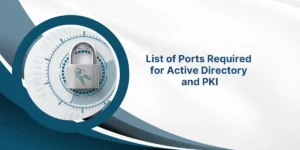Getting Started with Port 25
Port 25 is one of the well-known ports that is an essential part of Internet communication. It plays a vital role in sending and receiving emails. Understanding what port 25 is and how it functions provides insight into the underlying processes of email delivery. This comprehensive guide will explain what port 25 is, how it works, its vulnerabilities, and ways to secure it.
Key Takeaways
- Port 25 is the default SMTP port for sending and receiving emails. SMTP stands for Simple Mail Transfer Protocol.
- It establishes connections between mail servers to relay mail. Port 25 listens for incoming SMTP connections and outgoing SMTP connections.
- Since port 25 is vulnerable to attacks like email spoofing, many ISPs block it. Organizations also block port 25 to prevent malware and spam.
- Securing port 25 involves using encryption like TLS, enabling authentication, blocking spoofed IPs, and limiting connections.
- Alternatives like port 587 and port 465 can also be used for SMTP to avoid issues with port 25 blocking.
What is Port 25?
Port 25 is a well-known port number that serves as the default TCP/IP port for Simple Mail Transfer Protocol (SMTP) traffic. SMTP is an Internet standard protocol that manages sending and receiving emails reliably between servers.
When you send an email, your email client connects to your outgoing mail server on port 25 to relay the message using SMTP. The mail server then connects to the recipient’s incoming mail server, also on port 25, to deliver the email.
Port 25 provides the connection endpoint for SMTP mail transmission between mail servers. It establishes a channel for the source mail server to communicate with the destination mail server and transfer email messages between them.
Some key things to note about port 25:
- It is the standard TCP port assigned for SMTP by the Internet Assigned Numbers Authority (IANA).
- On servers, it is opened by the SMTP daemon process that listens for connections on this port.
- It uses TCP as the core transport protocol for reliability.
- Authentication mechanisms like SMTP AUTH can be used alongside port 25 for security.
- It is susceptible to various attacks, which led to many ISPs blocking it.
How Does Port 25 Work?
Port 25 works by facilitating the SMTP connection between the sending and receiving mail servers to relay email messages. Here is a high-level overview of how the SMTP process works with port 25:
- The user composes an email in their mail client (like Outlook) and hits send.
- The mail client contacts the configured outgoing SMTP mail server on port 25.
- The client establishes an SMTP session with the outgoing mail server over a port 25 TCP connection.
- The client sends the sender’s and recipient’s email addresses, message content, attachments, etc., as part of the SMTP protocol conversation.
- The outgoing mail server adds header information to the message. It then looks up the MX record of the recipient’s domain to find the incoming mail server.
- The outgoing server makes an SMTP connection over port 25 to the incoming mail server and transfers the email.
- The incoming mail server receives the message over the SMTP port 25 connection and deposits it in the recipient’s mailbox.
- The recipient can now access the email in their email client.
NTP uses the User Datagram Protocol (UDP) for its transport layer communication. UDP is preferred over TCP for time sync as it has lower overhead.
What are Some Common Port 25 Attacks
Since port 25 is a crucial access point for managing email transmission, it is also vulnerable to various attacks and exploits. Some common security risks associated with port 25 include:
- Email Spoofing
- Spamming
- Email Bombing
- Denial of Service
- Brute Force Attacks
- Malware spreading
- Data exfiltration
Email Spoofing
Spoofing the sender’s email address in the SMTP envelope and message headers to disguise the origin of spam and phishing emails.
Spamming
Exploiting open port 25 relays to send large volumes of unsolicited bulk emails.
Email Bombing
Overwhelming a recipient’s mailbox by sending a huge number of emails in a short period.
Denial of Service
Flooding the open port 25 with SYN requests to exhaust server resources and cause a DoS condition.
Brute Force Attacks
Guessing weak SMTP account passwords by brute forcing credentials via SMTP connections.
Malware spreading
Sending malware programs as email attachments through compromised port 25 access.
Data exfiltration
Stealing confidential data from the organization by sending it out via SMTP email messages.
These potential attacks make securing port 25 an essential requirement for organizations.
Why do ISPs block port 25?
Many ISPs and hosting providers intentionally block access to port 25 on their networks. There are good reasons why port 25 blocking is implemented:
- This is to prevent customers from being used as open email relays for spamming. Spammers previously exploited open SMTP relays to route huge volumes of unsolicited bulk emails.
- To mitigate SMTP server exploits, malware emails, phishing scams, etc., from the compromised devices of subscribers.
- To encourage customers to use the ISP’s designated outgoing SMTP servers instead of running their own. This gives ISPs more control and visibility.
- To limit the customer’s ability to send outbound emails directly and manage email delivery themselves.
- To reduce the load on their network infrastructure from high volumes of SMTP traffic.
- To force customers to upgrade to paid business plans if they need access to port 25 for commercial email usage.
How Can Organizations Secure Port 25?
Organizations that manage their email servers need to implement these measures to secure their port 25:
- Use TLS encryption: Require TLS security for all SMTP connections to encrypt port 25 traffic.
- Enable SMTP AUTH: Make SMTP authentication mandatory to verify identities over port 25.
- Block spoofed IPs: Identify and block source IP address spoofing at the firewall.
- Limit connections: Set rate limits and restrict the number of connections to port 25.
- Content filtering: Scan SMTP traffic for malware, spam, and phishing attacks.
- Update firewall rules: Configure IP-based firewall rules to control access.
- Monitor activity: Log and monitor port 25 activity to detect anomalies.
- Application layer filtering: Inspect SMTP commands, responses, banners, etc., for attacks.
- User access controls: Allow only authorized mail servers and hosts to connect internally.
- Disable open relaying: Configure the SMTP server not to allow unauthorized third-party relaying.
Port 25 Alternatives: Port 587 and Port 465
If port 25 is blocked, there are alternative ports that can be used for SMTP:
Port 587
Port 587 is the default SMTP submission port for mail clients to submit outgoing emails to the SMTP server. It establishes an SMTP connection from the client on an ephemeral port to the submission server on port 587. Communications are encrypted with TLS.
Key aspects:
- Used for SMTP submission from clients to server
- Supports SMTP with TLS encryption
- Requires client authentication
- Blocked by fewer organizations compared to port 25
Port 465
Port 465 is for SMTP over SSL (SMTPS). It establishes an encrypted SMTP connection over SSL from the client directly to the mail server using port 465. All communications are securely wrapped in an SSL tunnel.
Key aspects:
- Used for encrypted SMTPS connections
- Establishes secure SSL/TLS encrypted SMTP sessions
- Requires certificate validation
- Supported by all major email clients
- More secure than port 587 due to mandatory encryption
Final Thoughts
Port 25 is the fundamental SMTP email port that enables communication between sending and receiving mail servers for transferring emails. Understanding its purpose, vulnerabilities, and security provides key learning for managing email infrastructure.
While port 25 is commonly blocked due to attacks, alternatives like 587 and 465 allow secure SMTP submission through most ISPs. Implementing strong encryption, access restrictions, and activity monitoring helps organizations securely operate port 25 for email delivery.
Frequently Asked Questions About Port 25
What is port 25 used for?
Port 25 is the standard TCP/IP port used for SMTP (Simple Mail Transfer Protocol). It provides the connection endpoint for email transmission between sending and receiving mail servers.
Why is port 25 blocked?
Many ISPs and organizations block port 25 to prevent open mail relaying, restrict direct outbound emails, mitigate SMTP attacks, and manage email delivery through their servers.
Can port 25 be accessed through ISP?
Most consumer ISP plans block access to port 25. You will need a business account with the ISP to get port 25 access for running a mail server. Some allow port 25 traffic only to their SMTP servers.
Is port 25 required for sending emails?
Port 25 is required for directly sending outbound emails from your own SMTP server. But your ISP may not allow this. For general email clients, alternative ports like 587 and 465 work fine.
What ports should be open for SMTP?
Commonly open ports are 25 (SMTP), 587 (Submission), 465 (SMTPS), and 2525 (Alternative SMTP submission). Port 25 is the primary SMTP port but may be blocked, so 587 and 465 provide alternate options.
How do I change the SMTP port in Outlook?
In Outlook, go to File > Account Settings > Select your Email Account > Change > More Settings > Advanced tab. In the Outgoing mail server section, change the SMTP port from 25 to 587 or 465. Click Ok to save.
Can I use port 465 instead of port 25?
Yes, port 465 can be used instead of port 25 where it is blocked. Port 465 establishes an encrypted SMTPS connection for secure email submission. It requires SSL certificate validation and is more secure than port 25.
Is port 25 secure?
Port 25 uses plain text SMTP connections, which are not secure. They are susceptible to sniffing, spoofing, and man-in-the-middle attacks. Using encryption mechanisms like TLS, SSL and SMTP AUTH helps improve port 25 security.
How do I open port 25 for SMTP?
You’ll need admin access to the network. Add firewall rules to allow port 25 traffic from specific source IP subnets. Enable and configure the SMTP server daemon to listen on port 25. Restrict unauthorized relays. Use TLS encryption, SMTP AUTH, and other measures to secure it.

Priya Mervana
 Verified Web Security Experts
Verified Web Security Experts
Priya Mervana is working at SSLInsights.com as a web security expert with over 10 years of experience writing about encryption, SSL certificates, and online privacy. She aims to make complex security topics easily understandable for everyday internet users.



